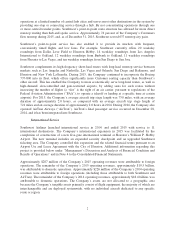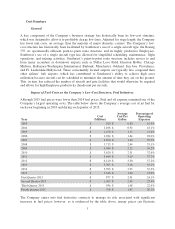Southwest Airlines 2015 Annual Report Download - page 20
Download and view the complete annual report
Please find page 20 of the 2015 Southwest Airlines annual report below. You can navigate through the pages in the report by either clicking on the pages listed below, or by using the keyword search tool below to find specific information within the annual report.must have an opportunity for eight hours of uninterrupted sleep within the rest period; and impose pilot
“flight time” and “duty time” limitations based upon report times, the number of scheduled flight
segments, and other operational factors. The rules affect the Company’s staffing flexibility, which
could impact the Company’s operational performance, costs, and Customer Experience.
In addition to its role as safety regulator, the FAA also operates the nation’s air traffic control system
and is in the midst of implementing a multi-faceted “next generation” air traffic control system
(“NextGen”). The Air Traffic Organization (“ATO”) is the operational arm of the FAA. The ATO is
responsible for providing safe and efficient air navigation services to all of the United States and large
portions of the Atlantic and Pacific Oceans and the Gulf of Mexico. The Company is subject to any
operational changes imposed by the FAA/ATO as they relate to the “NextGen” program, as well as the
day-to-day management of the air traffic control system. The FAA reauthorization discussed above
under “Aviation Taxes and Fees,” as well as the annual appropriation legislation that will fund the
DOT and the FAA in federal fiscal year 2017, could include provisions impacting future FAA safety-
related activities and ATO operations in 2016 and beyond.
The Company is subject to various other federal, state, and local laws and regulations relating to
occupational safety and health, including Occupational Safety and Health Administration and Food and
Drug Administration regulations.
Security Regulation
Pursuant to the Aviation and Transportation Security Act (“ATSA”), the Transportation Security
Administration (the “TSA”), a division of the U.S. Department of Homeland Security, is responsible for
certain civil aviation security matters. ATSA and subsequent TSA regulations and procedures implementing
ATSA address, among other things, (i) flight deck security; (ii) the use of federal air marshals onboard
flights; (iii) airport perimeter access security; (iv) airline crew security training; (v) security screening of
passengers, baggage, cargo, mail, employees, and vendors; (vi) training and qualifications of security
screening personnel; (vii) provision of passenger data to CBP; and (viii) background checks. Under ATSA,
substantially all security officers at airports are federal employees, and significant other elements of airline
and airport security are overseen and performed by federal employees, including federal security managers,
federal law enforcement officers, and federal air marshals. TSA personnel and TSA-mandated security
procedures can affect the Company’s operations, costs, and Customer experience. For example, as part of
its security measures, the TSA regulates the types of liquid items that can be carried onboard aircraft. In
addition, as part of its Secure Flight program, the TSA requires airlines to collect a passenger’s full name
(as it appears on a government-issued ID), date of birth, gender, and Redress Number (if applicable).
Airlines must transmit this information to Secure Flight, which uses the information to perform matching
against terrorist watch lists. After matching passenger information against the watch lists, Secure Flight
transmits the matching results back to airlines. This serves to identify individuals for enhanced security
screening and to prevent individuals on watch lists from boarding an aircraft. It also helps prevent the
misidentification of passengers who have names similar to individuals on watch lists. The TSA has also
implemented enhanced security procedures as part of its enhanced, multi-layer approach to airport security,
including physical pat down procedures, at security checkpoints. Such enhanced security procedures have
raised privacy concerns by some air travelers.
The Company, in conjunction with the TSA and CBP, participates in TSA PreCheck™, a pre-
screening initiative that allows a select group of low risk passengers to move through security
checkpoints with greater efficiency and ease when traveling. Eligible passengers may use dedicated
12
























